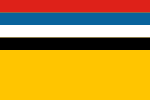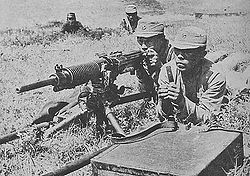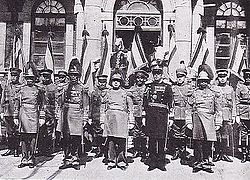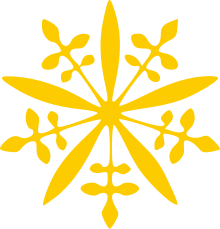- Manchukuo Imperial Army
-
Manchukuo Imperial Army 
Military Flag of ManchukuoActive 1932–1945 Country Manchukuo Allegiance Emperor of Manchukuo Type Army Engagements Second Sino-Japanese War
Soviet-Japanese Border Wars
World War II
Pacification of ManchukuoCommanders Ceremonial chief Emperor Puyi Notable
commandersXi Qia The Manchukuo Imperial Army was the armed force of the Japanese dominated puppet state of Manchukuo, serving as the land forces, along with the Manchukuo Imperial Guards. There was also a Manchukuo Imperial Air Force and a Manchukuo Imperial Navy.
Contents
History
After the Mukden Incident, the Imperial Japanese Army inherited approximated 60,000 troops of Marshal Zhang Xueliang's 160,000 strong Northeastern Army, who had defected to the Japanese with their generals. These Chinese turncoats included many isolated units the Japanese captured and interned in the rapid invasion of Manchuria along the railroad lines, and included:
- Lt. General Xi Qia of the Kirin Army.
- General Chang Hai-peng of the Hsingan Reclamation Army.
- General Zhang Jinghui of the Harbin Special District
The Manchukuo Imperial Army was formed from these forces after the establishment of the state of Manchukuo in March 1932. They were initially armed from the captured equipment and arsenals of the Northeastern Army. As many of the men were inexperienced recruits or irregular forces, and many were opium addicts, they were not of the highest grade in combat ability. Furthermore, many were simply mercenaries willing to fight for the side with the highest pay, and consequently the reliability, if not the loyalty, of many units of the early Manchukuo Imperial Army was questionable.
In August 1932, a unit of 2,000 men deserted their garrison at Wukimiho, taking their weapons over to the anti-Japanese guerrillas. Likewise, the Manchukuo 7th Cavalry revolted around the same time. According to one ranking Japanese officer, the main source of weapons against the Japanese and Manchukuo forces was the Manchukuo Army itself, and there were a number of cases where Manchukuo troops went into battle only to desert to the enemy en masse.[1] The most notable desertion was that of General and former Manchukuo War Minister Ma Zhanshan in April 1932 from the Heilongjiang Provincial Guard Army with several thousand troops along with many artillery pieces.
In its first form the Manchukuo Imperial Army was organized in seven Provincial Guard Armies (one for each province), with a total of over 111,000 men. An Independent Cavalry Brigade was created to provide a garrison for the capital of Hsinking, and the Manchukuo Imperial Guard was raised in February 1933 from men of Manchu ethnic backgrounds as part of the capital garrison to provide protection for Emperor Puyi and senior government officials.
In 1934, new regulations stated that only officers who had been trained by Manchukuo government approved schools would be permitted to serve in the Manchukuo Imperial Army. This was an effort to weed out the unreliable remnants of the former Northeastern Army, and to raise the standards and training of the army as a whole. It was also one of the first steps in an attempt to break the tradition of warlordism, wherein generals in command of a provincial army viewed their command area as a personal fiefdom for their own enrichment.
In 1938, military training academies were opened in Mukden and Hsinking.
Uniforms
Initially, the Manchukuo Imperial Army suffered from problems arising from the fact that its military uniform was indistinguishable from that of the anti-Japanese forces and bandits. This issue was rectified by 1934, with new uniforms in a style similar to that of the Imperial Japanese Army, and using a color-code system on the collar badges (black for military police, red for infantry, green for cavalry, yellow for artillery, brown for engineer and blue for transport).
Weapons
The early Manchukuo Imperial Army inherited a hodgepodge of weapons from the former Kuomintang arsenals, which created tremendous problems with maintenance and supply. For example, there were 26 kinds of rifles and over 20 kinds of pistols in use in 1932.
A priority was made to unify weaponry around the Type 38 Rifle as a standard, along with the Type 3 Heavy Machine Gun and Type 11 Light Machine Gun. Artillery units were to be equipped with the Type 38 Field Gun and Type 41 75 mm Mountain Gun.
By 1935, 50,000 Type 38 cavalry rifles had been imported from Japan and the machine guns were replaced over the next two or three years. By the start of the Pacific War, the weaponry of the Manchukuo Imperial Army was the almost same as the Japanese Army. Mauser pistols were used by soldiers and Browning and Colt pistols were used by the officers.
A military arsenal at Fengtien was established to produce rifles, machine guns and artillery. Ammunitions and small arms were ordered from the private factories in Manchukuo.
Infantry small arms
This is a list of standard infantry weapons in use in the Manchukuo Imperial Army:
- Mauser Type 1 Pistol!
- Mauser Type 2 or 3Pistol!
- Browning pistol
- Colt pistol!
- Type 38 Rifle!
- Type 99 Rifle!
- Type 38 Cavalry Rifle!
- Mauser Model 13 Rifle
- Type 11 Light Machine Gun!
- Czech LMGs!
- Type 96 Light Machine Gun
- Type 3 Heavy Machine Gun!
- Type 93 7.7 mm Heavy Machine Gun
Artillery
- Type 38 Field Gun
- Type 41 75 mm Mountain Gun!
- Krupp Mountain Guns
- Chinese 7 cm-caliber mortars
- Chinese 75 mm field guns
- Hand Grenade (stick type)!
- Type 10 Grenade Discharger!
Armored vehicles
Given the effectiveness of Soviet armored units in the Battle of Khalkhin Gol and other border clashes, it is surprising that more emphasis was not placed on the development of tanks by the Japanese and Manchukuo forces. The Manchukuo Imperial Army had a number of armored cars built by Isuzu and modified by the Dowa Automobile Company of Manchukuo. From 1943, some 10 Type 94 Tankettes were passed from Japanese forces to the Manchukuo Army to form one armored company. During the war, a Manchukuo version of the Mitsubishi Light Tank (Type 95 Ha-Go) in use in training tank schools, but did not reach substantial operational deployment.
Organization
1932 organization
The early Manchukuo Imperial Army organization is listed below.[2] Unit troop strengths are in parenthesis.[3] The total strength of the Manchukuo Imperial Army at its foundation was 111,044 men.
- Fengtien Guard Army (20,541 men)
- Headquarters (678)
- Teaching unit (2,718)
- 1st Mixed Brigade (2,467)
- 2nd Mixed Brigade (2,104)
- 3rd Mixed Brigade (2,467)
- 4th Mixed Brigade (1,755)
- 5th Mixed Brigade (1,291)
- 6th Mixed Brigade (2,238)
- 7th Mixed Brigade (2,014)
- 1st Cavalry Brigade (1,098)
- 2nd Cavalry Brigade (1,625)
- Kirin Guard Army - General Xi Qia (34,287 men)
- Headquarters (1,447)
- 2nd Teaching Unit (2,718)
- Infantry Detachment (1,163)
- Cavalry Detachment (1,295)
- 1st Infantry Brigade (2,301)
- 2nd Infantry Brigade (2,343)
- 3rd Infantry Brigade (2,496)
- 4th Infantry Brigade (3,548)
- 5th Infantry Brigade (3,244)
- 7th Infantry Brigade (2,343)
- 8th Infantry Brigade (2,301)
- 1st Cavalry Brigade (1,867)
- 2nd Cavalry Brigade (1,598)
- 3rd Cavalry Brigade (1,598)
- 4th Cavalry Brigade (2,037)
- Yilan Unit (706)
- Kirin Railway Guards (North Manchuria Railway Guard Force)
- HQ (151)
- Sanrin Unit (1,452)
- River Defense Fleet (640 men)
- Heilongjiang Guard Army - Ma Zhanshan (25,162 men)
- Headquarters (1,016)
- 3rd Teaching Unit (2,718)
- 1st Mixed Brigade (3,085)
- 2nd Mixed Brigade (3,085)
- 3rd Mixed Brigade (3,085)
- 4th Mixed Brigade (3,085)
- 5th Mixed Brigade (1,934)
- 1st Cavalry Brigade (2,244)
- 2nd Cavalry Brigade (2,244)
- 3rd Cavalry Brigade (2,666)
- Hsingan Army (4,374)
- South Hsingan Garrison (1,682)
- 3rd and 4th Cavalry Regiments
- Eastern Hsingan Garrison (1,818)
- 5th and 6th Cavalry Regiments
- Northern Hsingan Garrison (874)
- 7th and 8th Cavalry Regiments
- South Hsingan Garrison (1,682)
- Taoliao Army - Chang Hai-peng (17,945 men)
1934 reorganization
In August 1934 the Manchukuo Imperial Army was reoganized[4] into five district armies, each divided into two or three zones. Each zone had one or two Mixed Brigades assigned to it, as well as a training unit. The Mixed Brigades were formed of one or two infantry regiments, a cavalry regiment and an artillery or mortar company, with a strength of 2,414 men, 817 horses (in double infantry regiment units) or 1515 men, 700 horses (in single infantry regiment units). The cavalry brigades were formed of three cavalry regiments and an artillery or mortar company, with a strength of 1,500 men, 1,500 horses. The total strength of the Manchukuo Imperial Army at this time was 72,329 men. The new organization was:
- 1st District Army "Fengtien" - General Yu Chih-shan (12,321 men)
- 6 Mixed Brigades
- 2nd District Army "Kirin" - General Chi Hsing (13,185 men)
- 4 Mixed Brigades, 3 Cavalry Brigades
- 3rd District Army "Qiqihar" - General Chang Wen-tao (13,938 men)
- 5 Mixed Brigades, 1 Cavalry Brigade
- 4th District Army "Harbin" - General Yu Cheng-shen (17,827 men)
- 8 Mixed Brigades, 1 Cavalry Brigade
- 5th District Army "Chengde" - General Chang Hai-peng (9,294 men)
- 3 Mixed Brigades, 1 Cavalry Brigade
- Independent units:
- East Hingganling Guard Army
- West Hingganling Guard Army
- North Hingganling Guard Army
- South Hingganling Guard Army
- Seian Guard Army
- 1st Xingjing Cavalry Brigade
- River Fleet
1944 organization
By 1944 the manpower of the Manchukuo Imperial Army had increased to over 200,000 men according to Soviet intelligence sources. They reported the army had the following units:[5]
- 1st Division (3 infantry regiments, 1 artillery regiment)
- 1st Guards Brigade (2 infantry regiments of 2 battalions, 1 mortar company)
- 1st Cavalry Division (2 cavalry brigades, 1 battalion of horse artillery)
- 10 Infantry Brigades (2 infantry regiments of 2 battalions, 1 mortar company)
- 6 Cavalry Brigades (2 cavalry regiments, 1 battery of horse artillery)
- 21 Mixed Brigades (1 infantry regiment, 1 cavalry regiment, 1 battery mountain artillery)
- 2 Independent Brigades
- 7 Independent Cavalry Regiments
- 11 Artillery Units (one per District)
- 5 Anti Aircraft Regiments
1945 organization
Army of Manchukuo[6]
- 8 Infantry divisions
- 7 Cavalry divisions
- 14 Infantry and cavalry brigades
See also
References
- Hogg, Ian V.; Weeks, John (1977). Military Small Arms of the 20th Century. Arms & Armour Press / Hippocrene. ISBN 0-85368-301-8.
- Jowett, Philip (2005). Rays of the Rising Sun, Volume 1: Japan's Asian Allies 1931-45, China and Manchukuo. Helion and Company Ltd.. ISBN 1874622213.*Warner, Philip (1973). Japanese Army of World War II. Osprey Publishing. ISBN 0850451183.
External links
- Manchukuo Imperial Army March 1, 1932
- The Mighty Forces of Manchukuo
- August Storm: The Soviet Invasion of Manchukuo
Notes
- ^ Jowett, Rays of the Rising Sun
- ^ Jowett, Rays of The Rising Sun. Pg. 8-9.
- ^ Manchukuo Forces: Orbat
- ^ Jowett, Phillip S., Rays of The Rising Sun, Pg. 10-12.
- ^ Jowett, Rays of The Rising Sun, Pg. 36
- ^ August Storm: The Soviet Invasion of Manchukuo
Categories:- Military of Manchukuo
- Second Sino-Japanese War
- Disbanded armies
Wikimedia Foundation. 2010.





